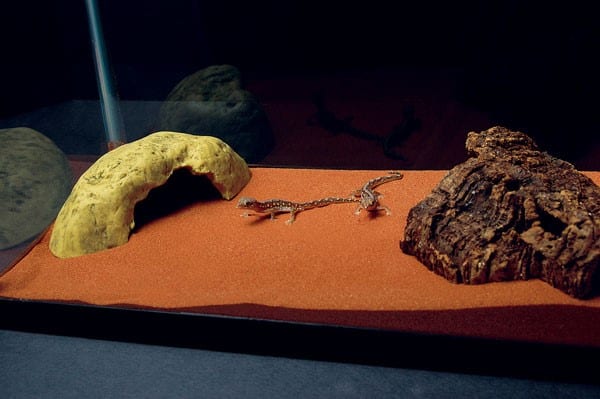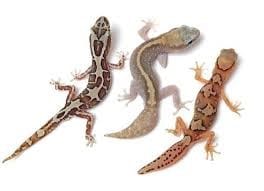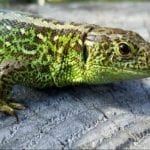You might have already heard that Australia is home to some of the unique types of animals that you can only possibly find in that small yet very naturally abundant continent. Due to how abundant it is in terms of the natural habitats it provides animals and how its climate and environmental conditions are fit for a wide variety of creatures, all sorts of exotic lizards live solely in Australia. This includes the Diplodactylus Geckos of Australia.
The Diplodactylus Geckos are some of the most beautiful types of lizards you can find anywhere else in the world. Moreover, they are native only to Australia and are some of the unique animals you can come across with especially due to how you probably have not seen anything like them in the past.
That said, because there are not a lot of other lizards that share the same type of looks and characteristics as the Diplodactylus Geckos, it might be a trickier reptile to take care of for beginners and experienced owners alike. As such, we have come up with a guide that may shed some light when it comes to safekeeping and taking care of these lizards.
Diplodactylus Geckos General Information
Overview
Diplodactylus Geckos are often called the stone geckos of Australia because they are often found under large stones to hide. Also, there are about 23 different types of lizards that fall under the Diplodactylus genus. All of those geckos have their own unique traits and characteristics. However, they all share similar characteristics that make them fall under the same classification. They have the same morphological characteristics, but they are actually distinct from one another in terms of their genetics.
As mentioned, Diplodactylus Geckos can only be found in Australia and are known widely to be found scattered all over Australia. They are much more common in the western and eastern coasts of the continent and can also be quite abundant near the southern coast. However, they seem to be much less common in the northern regions of Australia, probably due to how the climate there is not the most suitable for these geckos.
Physical Characteristics
The Diplodactylus Geckos of Australia tend to be really small and tiny reptiles that rarely grow over 4 inches and are at least only about a couple of inches long, even at adulthood. Meanwhile, they also hardly weight over 3 grams due to how tiny these geckos really are. There are even species of Diplodactylus Geckos that do not even grow longer than 2.5 inches. However, there may be some species of Diplodactylus Geckos that can reach 5 inches. That means that they are as small as any other type of lizard is. But that does not mean that they are not as appealing as many other different types of pet reptiles.
Diplodactylus Geckos may differ a bit in terms of their overall appearance depending on the type and on the species, but they usually have similar morphological characteristics. Most of these geckos tend to have fat tails that have given them the nickname “Fat-Tailed Gecko.” Some of these geckos may not have tails as fat as the others, but they generally have tails that are fatter than most other types of geckos. Some Diplodactylus Geckos have slender and longer tails, while others have short and stout tails that may be just as stout as the body of the lizard. But, generally, most of these lizards have tails that compose a third of its total weight. And like any other Gecko, these lizards will drop their tails whenever they feel threatened by potential predators. However, they can also grow these tails back.
Generally speaking, the Diplodactylus Geckos have short legs. However, those with stout and short tails tend to have shorter legs. Meanwhile, those with longer and slender tails tend to have comparatively long legs.
The color and the patterns on the body of the Diplodactylus Geckos depends on the type and on the species of this lizard. There are no exact types of colors or patterns, but they generally follow earth tones and patterns that allow them to easily blend in together with the earth or with rocks, where they usually hide.
Natural Habitat
In the wild, the Diplodactylus Geckos prefer to live in dry and arid conditions all over Australia and are much more common near coastal areas due to how the conditions there are much more suitable for this type of lizard. You can find them near shrubby and forested regions hiding underneath stones or plants. They may also be found under fallen trees or even burrows. As long as the hiding spot is good enough to keep these reptiles hidden, there is no reason why they will not hide there.
Eating Habits
Diplodactylus Geckos are insectivores that only eat small insects because of how small they are. They like eating crickets, cockroaches, worms, and many other insects that are smaller than this lizard’s mouth. It may have a harder time eating insects that are larger than its head. However, there are some species of Diplodactylus Geckos that eat termites instead of the usual diet of crickets.
Behavior and Temperament
Diplodactylus Geckos are quite shy animals that like to hide regardless of whether they are wild-caught or captive-bred. In the wild, they prefer to hide in anything that keeps them hidden from plain sight because it allows them to stay clear from the sight of potential predators, and it also shelters them from the extreme heat of the Australian sun.
All types of Diplodactylus Geckos are nocturnal animals that prefer to stay active at night instead of during the day because of how cool nighttime conditions are. They usually patrol their territories at night to look for food. Even captive-bred ones are likely to move around patrolling their enclosure to try to hunt for food.
How to Safekeep Diplodactylus Geckos of Australia
Enclosure

While the Diplodactylus Geckos vary in terms of their overall genetic characteristics, they generally have similar requirements when kept under captive care and in terms of what kind of conditions are best for them whenever you house them.
In terms of their cages, these geckos can be kept in a wide variety of enclosures that are not too complex. You can go for a small glass enclosure, such as a 5-gallon terrarium. As long as the enclosure is safe and sturdy enough for these lizards, the Diplodactylus Geckos will be able to live well there. Just be sure to close off openings that can be wide enough to allow these reptiles to escape.
Type of Food
The type of food you provide the Diplodactylus Geckos is not really specialized. They generally do well when fed with insects that are small enough for them. Crickets are good choices not only because they are easy to come by, but they are also small enough for the Diplodactylus Geckos. Do not feed them insects that are larger than two-third of the size of the gecko’s head.
However, there are certain types of Diplodactylus Geckos that require specialized diets in the wild such as those that do well when eating termites. Such geckos are best saved for experts who already know how to provide diets that are similarly specialized.
Water
Diplodactylus Geckos do not like drinking from a standing water source. Instead, it might be better if you provide these lizards with a way to drink water from droplets. Mist the enclosure on a regular basis so that they will have a way to drink water. However, make sure to only mist the cool part of the enclosure because they do not prefer to be kept in places that are quite humid. A light misting with lukewarm water should be your best bet since it keeps humidity levels low and temperatures high while providing these reptiles with the water drops they need.
Substrate
Using sand as a substrate is a good choice for you because it does not keep moisture, as well as other types of substrates, do. Make sure that the sand is about an inch deep so that it is deep enough to allow your Diplodactylus Geckos to burrow when needed.
Heating and Humidity
Diplodactylus Geckos are used to conditions that are warm. That means that it is always a good idea to keep them in enclosures that provide enough warmth to these animals. However, the one thing you need to consider here is that Diplodactylus Geckos are nocturnal and do not do well when provided with a strong light source. That means that providing heat without the use of a lamp should be the best choice for you. Use an under-the-tank heating pad in that regard so that the tank stays heated without providing unnecessary light. The temperature should be somewhere close to 85 degrees Fahrenheit but can be as cool as about 75 degrees at the coolest portion of the enclosure.
When it comes to how humid the enclosure should be, make sure to keep conditions dry because Diplodactylus Geckos love dry and arid environments. Keep humidity levels low and make sure that you do not overdo it when you are misting these reptiles’ enclosure.
Furnishings
The purpose of putting furnishings inside the Diplodactylus Geckos’ enclosure is to allow them places to hide whenever they need to. Always remember that the Diplodactylus Geckos are shy animals that prefer to stay hidden. In that sense, you can use all sorts of decorations that can be used as hiding spots. Stones, rocks, tree barks, or even a plastic container with an opening can be used as good hiding spots for your Diplodactylus Geckos.



